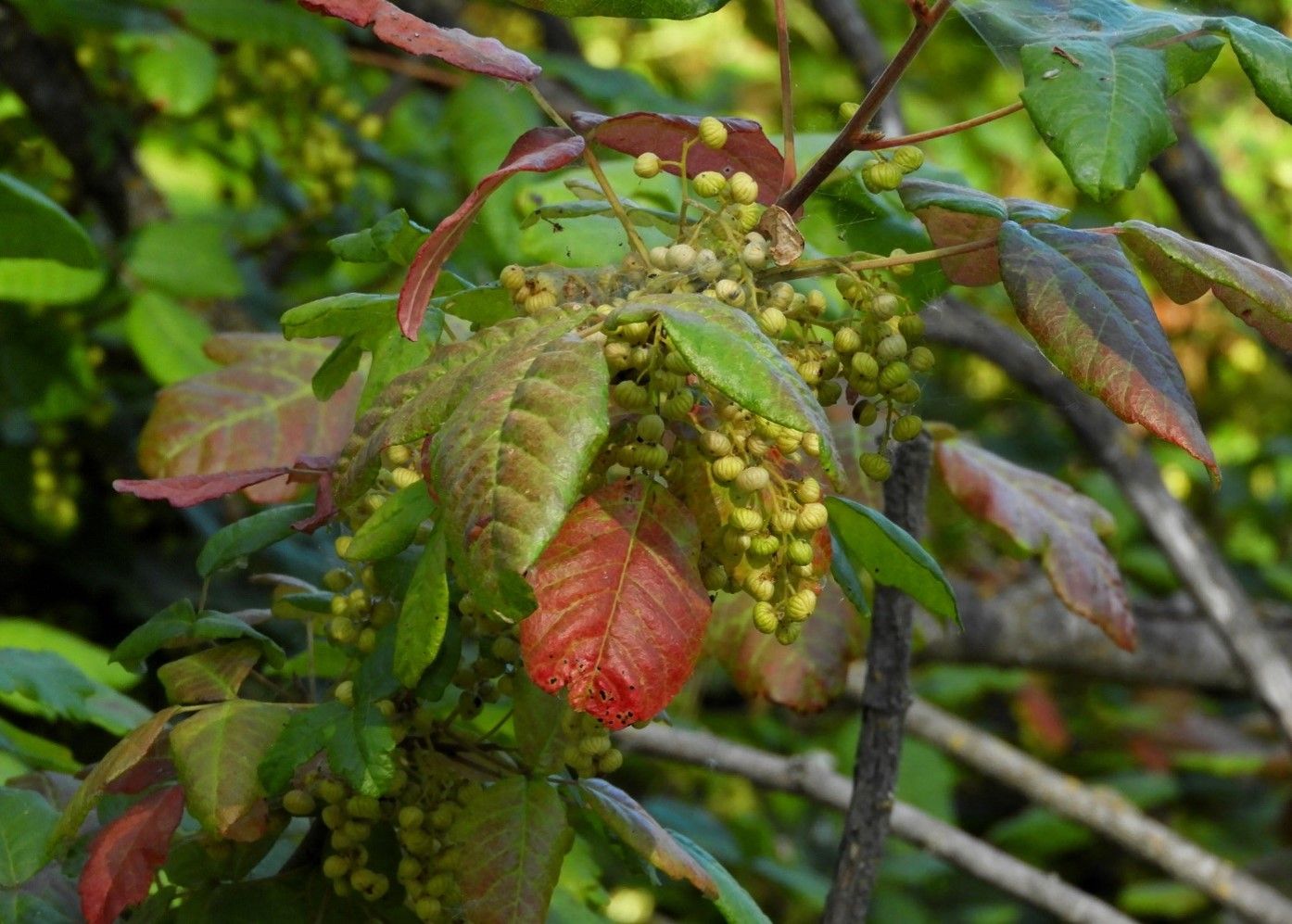Monumental Questions - Can I still get Poison Oak in the Winter?

YES!
Leaves of three - let them be. Right but it’s winter and what if there are no leaves?
Poison Oak (Toxicodendron diversilobum), Pacific Poison Oak or Western Poison Oak is a widely distributed woody shrub or vine that belongs to the Sumac (Anacardiaceae) family. The Sumac family is also known as the Cashew family which contains the tree that gives us that delightful buttery nut (it’s actually a seed) as well as the tree that provides mouthwatering mangos and the tree that produces savory pink peppercorns. How can such a delectable family also give us such an annoying plant?
Poison oak (PO) is not even remotely related to oaks but the leaves sort of resemble oak leaves. They are divided into three leaflets that are about one and a half to four inches long. The species name, diversilobum, refers to the diversity of leaf size and shape; the edges can be toothed, scalloped or lobed and vary greatly. PO is deciduous and the new leaves are usually dark golden or bronze when they are just beginning to unfold in early to mid-spring. They turn a bright then darker glossy green and ultimately transitioning a stunning scarlet red then fading to pink in late summer and fall. The small flowers are greenish-white and appear in late spring to mid-summer and if they are fertilized they become small creamy white berries. Growth forms vary depending on where it is occurring, but it thrives in full sun as well as shady environments. In open sunlight it can grow as a tall, dense shrub or tree with a thick trunk, or a woody vine winding around and up into the canopy of tall trees, fences and other vegetation. In shady areas it can occur as a dense thicket, vine or anything in between. It is prolific and spreads by seed dispersal and through underground rhizomes.
It is widely distributed in Western North America from British Columbia, Washington, Oregon, California, Nevada and Baja Mexico and occurs extensively throughout the Berryessa Snow Mountain National Monument. It occurs in chaparral and woodland habitats as well as coastal sage scrub, grasslands, oak woodlands and mixed evergreen forests below 5,000 feet. It’s a common understory plant in riparian corridors and grows alongside Giant and Coastal Redwoods. PO is even a constant quagmire in dry-farmed mountain orchards, urban parks and recreation areas. In fact, it’s kind of hard to find a biome in the Central Valley of California that doesn’t support Poison Oak unless you go into the Great Basin or the southwestern edge of the Mojave desert.
The genus Toxicodendron contains many plants that cause allergic reactions. The oil of the plants contains a compound called Urushiol that causes the reaction and it is found in all parts of the plant except the pollen (ironic!). Direct contact with the plant or anything that has touched the plant such as clothing, pets, tools or vehicles can result in painful, itchy blisters. Not everyone is allergic to it, however, repeated exposure can lead to heightened sensitivity. If an area dense with PO is burning, inhaling the smoke can cause a severe internal reaction.
Which leads me to why you can still have a reaction to PO in the winter after all the leaves have fallen. It’s a lot harder to spot when it’s just a twig, branch or bare vine along the edge of the trail. Twigs and stems still contain the oil that produces reactions and you may not even realize that you’ve brushed up against it until it’s too late. Keep an eye out for exposed, reddish-brown whip-like sticks coming out of the ground, especially if you know you’re in an area where PO is present. Sometimes the berries remain on the plant even though the leaves have fallen off and occasionally the stems show black marks where the sap may have oozed out and dried. If you know you’ve been in contact with PO, washing your exposed skin with dish soap is a great way to remove the oil from your skin and washing your clothes as soon as you can so you don’t transfer the oil to yourself, others or additional laundry is also a good idea. If your pets have been scampering about where PO could be present, give them a good bath before you snuggle up with them and consider wearing long rubber gloves like those made for doing dishes to avoid the oils transferring to you.
PO isn’t all bad; Black-tailed Deer, California Ground Squirrels and Western Gray Squirrels among other species consume the leaves of the plant which is rich in phosphorus, calcium and sulfur. Many birds eat the berries and utilize the plant for shelter. Research has shown that livestock, domestic dogs and other native wildlife species do not have adverse reactions to Urushiol. Native Americans cooked with it, used the stems to make baskets and used the juice from the fruit to dye materials black.
Don’t stay off the trail, just take precautions and enjoy winter hiking in your favorite monument!
-Kristie Ehrhardt (kehrhardt@tuleyome.org)
Tuleyome Land Conservation Program Manager
RECENT ARTICLES






